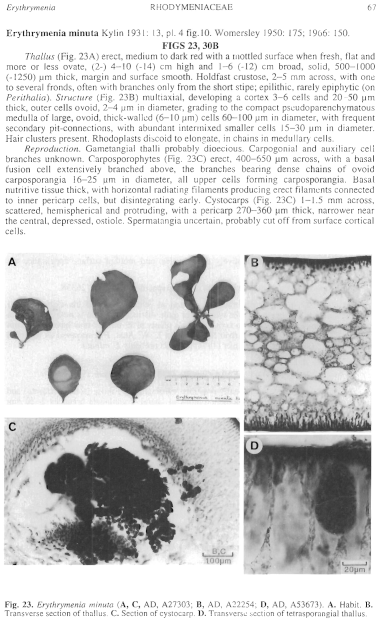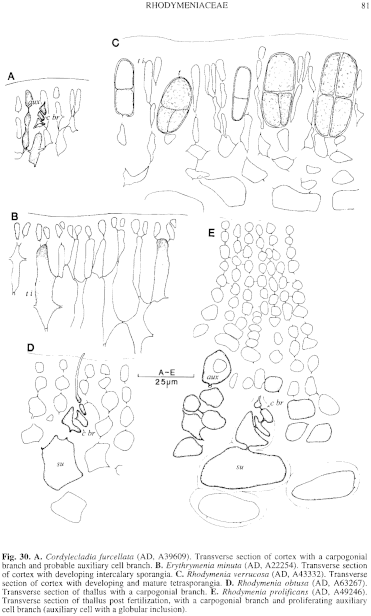|
|
|
|
|
|||||||||||
|
Electronic Flora of South Australia Species Fact Sheet
Phylum Rhodophyta – Class Florideophyceae – Order Rhodymeniales – Family Rhodymeniaceae
Selected citations: Womersley 1950: 175; 1966: 150.
Thallus (Fig. 23A) erect, medium to dark red with a mottled surface when fresh, flat and more or less ovate, (2–) 4–10 (–14) cm high and 1–6 (–12) cm broad, solid, 500–1000 (–1250) µm thick, margin and surface smooth. Holdfast crustose, 2–5 mm across, with one to several fronds, often with branches only from the short stipe; epilithic, rarely epiphytic (on Perithalia). Structure (Fig. 23B) multiaxial, developing a cortex 3–6 cells and 20–50 µm thick, outer cells ovoid, 2–4 µm in diameter, grading to the compact pseudoparenchymatous medulla of large, ovoid, thick-walled (6–10 µm) cells 60–100 µm in diameter, with frequent secondary pit-connections, with abundant intermixed smaller cells 15–30 µm in diameter. Hair clusters present. Rhodoplasts discoid to elongate, in chains in medullary cells.
Reproduction: Gametangial thalli probably dioecious. Carpogonial and auxiliary cell branches unknown. Carposporophytes (Fig. 23C) erect, 400–650 µm across, with a basal fusion cell extensively branched above, the branches bearing dense chains of ovoid carposporangia 16–25 µm in diameter, all upper cells forming carposporangia. Basal nutritive tissue thick, with horizontal radiating filaments producing erect filaments connected to inner pericarp cells, but disintegrating early. Cystocarps (Fig. 23C) 1–1.5 mm across, scattered, hemispherical and protruding, with a pericarp 270–360 µm thick, narrower near the central, depressed, ostiole. Spermatangia uncertain, probably cut off from surface cortical cells.
Tetrasporangia (Fig. 23D) in scattered cortical sori, not elevated but with longer mid cortical cells (L/D 4–6), transformed from intercalary cortical cells (Fig. 30B) and often with lateral secondary pit-connections as well as connections to outer cortical cells, elongate-ovoid, 50–85 µm long and 30–45 µm in diameter, decussately divided.
Type from Port Phillip Heads, Vic. (Wilson, 31.i.1890); lectotype (Kylin) in Herb. Agardh, LD, 26337.
Selected specimens: Ocean Reef Marina, Sorrento, W. Aust., 6 m deep (Millar & O'Brien, 9.xii.1980; MELU, Kraft 7326). Walker Rock, Anxious Bay, S. Aust., 8–10 m deep (Edyvane, 1.x.1982; AD, A53673). Elliston, S. Aust., 6 m deep, shaded, near entrance (Shepherd, 24.x.1969; AD, A34781). South West R., Kangaroo I., S. Aust., reef edges (Womersley, 17.i.1965; AD, A28902). Pennington Bay, Kangaroo I., S. Aust., drift (Womersley, 25.i.1946; AD, A3102) and upper sublittoral (Kraft & Min-Thein, 1.xii.1971; AD, A41376). Margaret Brock Reef, Cape Jaffa, S. Aust., 10 m deep (R. Lewis, 15.ii.1974; AD, A45034). Robe, S. Aust., upper sublittoral (Womersley, 28.iii.1959; AD, A22254 and 29.i.1964; AD, A27303). 1.3 km off Cape Northumberland, S. Aust., 15 m deep (Shepherd, 13.ii.1976; AD, A55102). Lawrence Rock, Portland, Vic., in low pool (Beauglehole, 15.i.1960; AD, A24014). Warrnambool, Vic., drift on Perithalia (Kraft 7586, 10.viii.1984; MELU). Portsea, Vic., outer coast, 20 m deep (Macpherson, 15.v.1963; AD, A28814). Satellite I., D'Entrecasteaux Ch., Tas., 2–7 m deep (Shepherd, 17.ii.1972; AD, A41748). Fluted Cape, Bruny I., Tas., 0–6 m deep (Shepherd, 12.ii.1972; AD, A41870).
Distribution: Sorrento , W. Aust., to Portsea, Vic., and the east coast of Tasmania.
Taxonomic notes: E. minuta is found on rough-water coasts at and just below low tide level, extending to 15 m deep. The ovate form, relatively thick blades, and mottled surface appearance are distinctive.
Kylin's photo of the lectotype includes also one specimen from LD, 26338.
Harvey (1862, pl. 237) illustrated E. minuta as young plants of his Calliblepharis (=Hymenocladia) conspersa, but the two appear quite distinct and there is nothing in Herb. Harvey, TCD, to associate the two taxa. Harvey's plants of E. minuta may have been from his Port Fairy, Vic., record rather than from Garden I., W. Aust. H. conspersa as recorded from Hogan I., Bass Strait, by Saenger (1974, p. 80) is probably E. minuta.
References:
HARVEY, W.H. (1862). Phycologia Australica. Vol. 4, Plates 181–240. (Reeve: London.)
KYLIN, H. (1931). Die Florideenordnung Rhodyméniales. Lunds Univ. Årsskr. N.F. Avd. 2, 27 (11), 1–48, Plates 1–20.
SAENGER, P. (1974). Natural History of the Hogan Group. 2. Some marine algae from Hogan Island, Bass Strait, with an account of the marine zonation. Pap. Proc. R. Soc. Tas. 107, 73–81.
WOMERSLEY, H.B.S. (1950). The marine algae of Kangaroo Island. III. List of Species 1. Trans. R. Soc. S. Aust. 73, 137–197.
WOMERSLEY, H.B.S. (1966). Port Phillip survey, 1957–1963: Algae. Mem. natn. Mus., Vict. No. 27, 133–156.
The Marine Benthic Flora of Southern Australia Part IIIB complete list of references.
Publication:
Womersley, H.B.S. (28 June, 1996)
The Marine Benthic Flora of Southern Australia
Rhodophyta. Part IIIB. Gracilarialse, Rhodymeniales, Corallinales and Bonnemaisoniales
Reproduced with permission from The Marine Benthic Flora of Southern Australia Part IIIB 1996, by H.B.S. Womersley. Australian Biological Resources Study, Canberra. Copyright Commonwealth of Australia.
Illustrations in Womersley Part IIIA, 1996: FIGS 23, 30B.

Figure 23 enlarge
Fig. 23. Erythrymenia minuta (A, C, AD, A27303; B, AD, A22254; D, AD, A53673). A. Habit. B. Transverse section of thallus. C. Section of cystocarp. D. Transverse section of tetrasporangial thallus.

Figure 30 enlarge
Fig. 30. A. Cordylecladia furcellata (AD, A39609). Transverse section of cortex with carpogonial branch and probable auxiliary cell branch. B. Erythrymenia minuta (AD, A22254). Transverse section of cortex with developing intercalary sporangia. C. Rhodymenia verrucosa (AD, A43332). Transverse section of cortex with developing and mature tetrasporangia. D. Rhodymenia obtusa (AD, A63267). Transverse section of thallus with a carpogonial branch. E. Rhodymenia prolificans (AD, A49246). Transverse section of thallus post fertilization, with a carpogonial branch and proliferating auxiliary cell branch (auxiliary cell with a globular inclusion).

|
Email Contact: State Herbarium of South Australia |

|